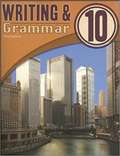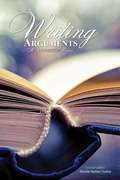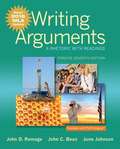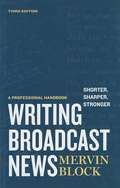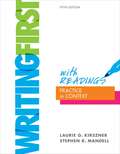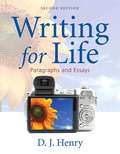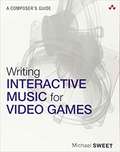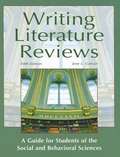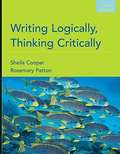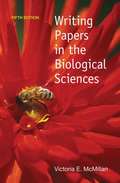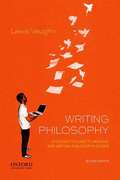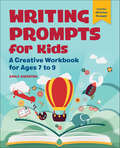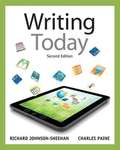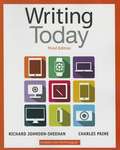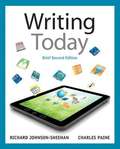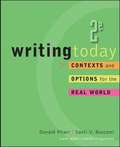- Table View
- List View
Writing Analytically (6th Edition)
by David Rosenwasser Jill StephenRosenwasser and Stephen (Muhlenberg College, Allentown, PA) show undergraduate students in first-year writing courses, as well as those in more advanced writing-intensive courses in various subjects, how to learn to analyze information and use writing to discover and develop ideas. They explain how to become more observant and push observations to implications and conclusions; use evidence, evolve claims, and converse with sources to write analytical papers; and understand organization, disciplinary formats, introductions and conclusions, and grammar and style. Writing exercises that can be applied to print and visual, text-based, and experiential materials are included, as are tips from professors on differences in disciplines other than English, rhetoric, or composition. This edition has a new introductory chapter previewing key topics, more examples, and more lists and rationales. It has two toolkit chapters on analytical methods instead of one, some reorganization and reformatting, more description of discipline-specific writing (especially the natural and social sciences), and new material in chapters on form. It has new sections on Rogerian argument, practical reasoning, and figurative logic, and expanded treatment of the four documentation styles. It clarifies step-by-step instructions, uncovering assumptions, and the method of looking for patterns of repetition and contrast. Another edition of the book includes readings. Annotation ©2012 Book News, Inc. , Portland, OR (booknews. com)
Writing And Grammar 10, Student Text
by Elizabeth Rose Kimberly Y. Stegall Dana Gibby Gage Bob Jones University Press StaffWriting & Grammar Grade 10 - Student Text. Teach the eight parts of speech, verbal phrases, clauses (including noun clauses), usage, and mechanics. Review the five basic sentence patterns: S-be-Advl and S-Trv-DO-OC. Reference chapters include library skills such as test-taking strategies. Lead students through the writing process and teach writing strategies such as sentence expansion and reduction, coordination and subordination, and parallelism. Writing projects include persuasive speech, editorial, eyewitness report, research essay, cause-and-effect essay, short story, poetry and metaphor, and webpage design.
Writing And Grammar: Communication in Action (Ruby Level, Grade 11, Texas edition)
by Joyce Armstrong Carroll Gary Forlini Edward E. WilsonThe Texas Test Preparation pages are designed to help you approach the TAAS and TASP tests with confidence.
Writing Arguments: A Rhetoric And Reader
by Brenda Herbert HarkerA reading companion for both the teachers and the students as they pursue the argumentative writing course; equipped with essays with different styles selected for viewpoint and meaning.
Writing Arguments: A Rhetoric With Readings
by John D. Ramage John C. Bean June JohnsonTeach students to read arguments critically and to produce effective arguments. Writing Arguments: A Rhetoric with Readings, Concise Edition, Seventh Edition integrates four different approaches to argument: the enthymeme as a logical structure, the classical concepts of logos, pathos, and ethos, the Toulmin system, and stasis theory. Focusing on argument as dialogue in search of solutions instead of a pro-con debate with winners and losers, it is consistently praised for teaching the critical-thinking skills needed for writing arguments. Major assignment chapters each focus on one or two classical stases (e.g. definition, resemblance, causal, evaluation, and policy). Each concept is immediately reinforced with discussion prompts, and each chapter ends with multiple comprehensive writing assignments.
Writing Broadcast News: Shorter, Sharper, Stronger
by Mervin BlockMervin Block- who has written for the best in the business- offers timeless advice, guiding both first-year students and seasoned professionals through the essentials of writing for the ear. With countless scripts collected from writing workshops in newsrooms across the country, this resource is studded with insightful- and at times entertaining- comments, suggestions and much-needed corrections. Readers will find Block's clear and incisive voice coming through in the expanded "Top Tips of the Trade" and the "Dozen Deadly Sins"—reminding us that mistakes can be our best teachers. New "WordWatcher" boxes highlight the challenges in writing for print versus broadcast.
Writing Companion, Grade 6
by Perfection LearningThe first chapter of this book provides instruction and activities to help develop the characteristics of good writing listed above. Each of the next five chapters focuses on a different type of writing. In each of these five chapters, the first several lessons highlight the elements particularly important to one type of writing. For example, the chapter on arguments includes lessons that focus on claims and counterclaims. The next-to-last lesson in each chapter takes you, step-by-step, through writing a text. Built into these lessons are instruction and practice in grammar and usage that address the most common writing problems. The final lesson in each chapter provides prompts for you to demonstrate your skills in gathering, analyzing, and using information in your writing. This lesson ends with a checklist based on the characteristics of good writing.
Writing Companion, Grade 8
by Perfection LearningThe first chapter of this book provides instruction and activities to help develop the characteristics of good writing listed above. Each of the next five chapters focuses on a different type of writing. In each of these five chapters, the first several lessons highlight the elements particularly important to one type of writing. For example, the chapter on arguments includes lessons that focus on claims and counterclaims. The next-to-last lesson in each chapter takes you, step-by-step, through writing a text. Built into these lessons are instruction and practice in grammar and usage that address the most common writing problems. The final lesson in each chapter provides prompts for you to demonstrate your skills in gathering, analyzing, and using information in your writing. This lesson ends with a checklist based on the characteristics of good writing.
Writing Companion, High School Level-B
by Perfection LearningThe first chapter of this book provides instruction and activities to help develop the characteristics of good writing listed above. Each of the next five chapters focuses on a different type of writing. In each of these five chapters, the first several lessons highlight the elements particularly important to one type of writing. For example, the chapter on arguments includes lessons that focus on claims and counterclaims. The next-to-last lesson in each chapter takes you, step-by-step, through writing a text. Built into these lessons are instruction and practice in grammar and usage that address the most common writing problems. The final lesson in each chapter provides prompts for you to demonstrate your skills in gathering, analyzing, and using information in your writing. This lesson ends with a checklist based on the characteristics of good writing.
Writing Essentials
by Sandra Panman Richard PanmanThis book teaches students the kind of writing required for school assignments, written exams, and the workplace. It consists of twelve chapters grouped into three major sections. The first part of the book teaches how to write resumes and business letters. The second section focuses on writing essays using four of the major writing strategies: narration, description, exposition, and persuasion. The last part guides students through writing book reports, short reports, and research papers.
Writing First With Readings: Practice In Context
by Laurie G. Kirszner Stephen R. MandellBest-selling authors and veteran college writing instructors Laurie Kirszner and Stephen Mandell believe that students learn to write best when they use their own writing as a starting point. In Writing First with Readings: Practice in Context, designed for the paragraph to essay course, Kirszner and Mandell take seriously the ideas and expressive abilities of developmental students, as well as their need to learn the rules of writing and grammar. Visual writing prompts that open every chapter get students writing immediately. By moving frequently between their own writing, writing models and instruction, and workbook-style mastery exercises, students get constant reinforcement of the skills they are learning. Thoughtful chapters on college success, research, and critical reading, along with high-interest essays, round out the text, making it the perfect introduction to college writing.
Writing For Life (Second Edition)
by D. J. HenryD. J. Henry wrote Writing for Life from the ground up for today's college student. The ground-breaking approach of combining instruction and visual tools makes writing, reading and thinking processes visible, and shows the processes rather than just telling students about them. Highly graphic layouts and unique visual pedagogy empower students to transfer the learning strategies they already use in interpreting the visual world to the task of writing.
Writing In The Social Sciences: A Guide For Term Papers And Book Reviews
by Jake MullerIdeal for students new to academic writing, Writing in the Social Sciences, Second Edition, is a clear, step-by-step guide to the entire writing process. Students will learn how to select and research a topic, develop and refine their ideas into a comprehensive outline, and convert the outline into a research paper or book report.
Writing Interactive Music for Video Games: A Composer's Guide (Game Design)
by Michael SweetWritten by the developer of Berklee School of Music’s pioneering game scoring program, this guide covers everything professional composers and music students need to know about composing interactive music for video games, and contains exclusive tools for interactive scoring―tools that were previously available only at Berklee. <p><p> Drawing on twenty years of professional experience in the game industry, Michael Sweet helps you master the unique language of music storytelling in games. Next, he walks you through the entire music composition process, from initial conceptualization and creative direction through implementation. <p><p> Inside, you’ll find dozens of examples that illustrate adaptive compositional techniques, from small downloadable games to multimillion dollar console titles. In addition, this guide covers the business side of video game composition, sharing crucial advice about contracts, pricing, sales, and marketing.
Writing Literature Reviews: A Guide for Students of the Social and Behavioral Sciences
by Jose L. GalvanThis easy-to-follow guide instructs students in the preparation of literature reviews for term projects, theses, and dissertations. There are numerous examples from published literature reviews that illustrate the guidelines discussed in this text. New to this edition: Most of the examples have been updated with material from recently published research. Also new: Seven new model literature reviews for discussion and evaluation have been added. Guides students in the preparation of literature reviews for term projects, theses, and dissertations. Chapters are conveniently divided into easy-to-follow guidelines, sequential steps, or checklists. Numerous examples throughout the book show students what should and should not be done when writing reviews. Emphasizes critical analysis of reports of empirical research in academic journals-making it ideal as a supplement for research methods courses. This book makes it possible for students to work independently on a critical literature review as a term project. Nine model literature reviews at the end of the book provide the stimulus for homework assignments and classroom discussions. The activities at the end of each chapter keep students moving toward their goal of writing a polished, professional review of academic literature. New to this edition: Most of the examples have been updated with material from recently published research. Also new: Seven new model literature reviews for discussion and evaluation have been added.
Writing Logically, Thinking Critically
by Sheila Cooper Rosemary PattonThis concise, accessible text teaches students how to write logical, cohesive arguments and how to evaluate the arguments of others. Integrating writing skills with critical thinking skills, this practical book teaches students to draw logical inferences, identify premises and conclusions and use language precisely. Students also learn how to identify fallacies and to distinguish between inductive and deductive reasoning. Ideal for any composition class that emphasizes argument, this text includes coverage of writing style and rhetoric, logic, literature, research and documentation.
Writing Logically, Thinking Critically (6th Edition)
by Sheila Cooper Rosemary PattonThis concise, accessible text teaches students how to write logical, cohesive arguments and how to evaluate the arguments of others. Integrating writing skills with critical thinking skills, this practical book teaches students to draw logical inferences, identify premises and conclusions and use language precisely. Students also learn how to identify fallacies and to distinguish between inductive and deductive reasoning. Ideal for any composition class that emphasizes argument, this text includes coverage of writing style and rhetoric, logic, literature, research and documentation.
Writing Papers in the Biological Sciences (Fifth Edition)
by Victoria E. McmillanWritten by a professional biologist who is also an experienced writing teacher, this comprehensive guide for students writing in biology, zoology, and botany provides detailed instruction on researching, drafting, revising, and documenting papers, reviews, poster presentations, and other forms of writing.
Writing Philosophy: A Student's Guide to Reading and Writing Philosophy Essays
by Lewis VaughnThis second edition of Writing Philosophy, aspires to help philosophy teachers address a big problem--the conflict between trying to teach course content and dealing with students who are ill prepared to write papers on that content. The dilemma is acute because writing is both a valuable teaching tool and a vehicle for assessing understanding. Using class time to explain the unique demands of philosophical writing, however, can divert time and attention from the real meat of a course. This book tries to come as close as possible to the ideal of a brief, self-guided manual that covers the basics of argumentative essay writing and encourages rapid learning with minimal teacher input.
Writing Prompts for Kids: A Creative Workbook for Ages 7 to 9
by Emily AierstokInspire kids to bring their ideas to life with creative story prompts for ages 7 to 9The world's best authors all have one thing in common: practice! This workbook features 60 fun writing prompts for kids that will help them build their writing skills and explore new ideas. With each one, they'll spark their curiosity and creativity as they craft original stories with confidence. 60 awesome writing prompts—From superheroes to time travel to floating castles, kids can try their hand at story starters that push the limits of their imagination. Tips for better storytelling—Kids will discover what makes a good story, including character development, narrative structure, and unique settings. Encouraging messages—Motivational advice helps kids continue developing their voice and talents! Supercharge your child's storytelling skills with this guide to creative writing for kids.
Writing Today
by Richard Johnson-Sheehan Charles PaineWith a clear and easy-to-read presentation, visual instruction and pedagogical support, Writing Today is a practical and useful guide to writing for college and beyond. This text teaches how to transfer their writing skills to careers. By teaching kinds of writing (analyses, reports, proposals, etc. ), strategies for writing (narration, comparison, argumentation, etc. ), and processes for writing (planning, drafting, revising, etc. ), Writing Today provides the writer with tools they can mix and match as needed to respond effectively to many writing situations.
Writing Today
by Richard Johnson-Sheehan Charles PaineAccessible to students and flexible for instructors, Writing Today, Third Edition introduces students to the conventions of writing memoirs, profiles, literary analyses, arguments, research papers, and more. Each chapter features a step-by-step process for composing within a given genre, as well as exemplary student and professional readings to promote rhetorical knowledge and critical analysis. The 42 short chapters, the chunked writing style, and visual instruction work to ensure that students will transfer the skills and strategies practiced in your class to their other classes, their lives, and their careers. From its graphic “Quick Start Guides” to its “Write This” prompts, Writing Today challenges students to extend the boundaries of their writing abilities as they practice composing for the real world.
Writing Today (Brief Edition)
by Richard Johnson-Sheehan Charles PaineWith a clear and easy-to-read presentation, visual instruction and pedagogical support, Writing Today is a practical and useful guide to writing for college and beyond. This text teaches how to transfer their writing skills to careers. By teaching kinds of writing (analyses, reports, proposals, etc. ), strategies for writing (narration, comparison, argumentation, etc. ), and processes for writing (planning, drafting, revising, etc. ), Writing Today provides the writer with tools they can mix and match as needed to respond effectively to many writing situations.
Writing Today (Brief Third Edition)
by Richard Johnson-Sheehan Charles PaineThis version of Writing Today, Brief Edition has been updated to reflect the 8th edition of the MLA Handbook (April 2016). The 8th edition introduces sweeping changes to the philosophy and details of MLA works cited entries. Responding to the “increasing mobility of texts,” MLA now encourages writers to focus on the process of crafting the citation, beginning with the same questions for any source. These changes, then, align with current best practices in the teaching of writing which privilege inquiry and critical thinking over rote recall and rule-following. <p><p> Accessible to students and flexible for instructors, Writing Today, Brief Edition, Third Edition introduces students to the conventions of writing memoirs, profiles, literary analyses, arguments, research papers, and more. Each chapter features a step-by-step process for composing within a given genre, as well as exemplary student and professional readings to promote rhetorical knowledge and critical analysis. The 32 short chapters, the chunked writing style, and visual instruction work to ensure that students will transfer the skills and strategies practiced in your class to their other classes, their lives, and their careers. From its graphic “Quick Start Guides” to its “Write This” prompts, Writing Today, Brief Edition challenges students to extend the boundaries of their writing abilities as they practice composing for the real world.
Writing Today: Contexts and Options for the Real World (2nd edition)
by Donald Pharr Santi BuscemiWriting Today begins with a chapter helping students learn the skills they will need to thrive throughout college and continues to promote reading and writing as practical tools both in college and in the work world. Full chapters on Group Projects and Oral Presentations teach students how to not only be successful in the classroom, but in the world of work as well. Students are sure to be engaged as they focus on the both the academic and professional contexts of writing.

